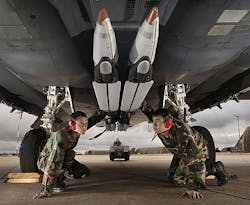Officials of the Rapid Acquisition Cell of the Air Force Lifecycle Management Center at Eglin Air Force Base, Fla., announced an $11.6 million contract Wednesday to Scientific Systems Co. In. in Woburn, Mass., to demonstrate the company's ImageNav technology on the Small-Diameter Bomb (SDB).
Scientific Systems's ImageNav is a vision-based navigation and precision targeting system for cruise missiles and manned and unmanned aircraft. ImageNav compares a terrain database with the host platform's sensor to determine if it's on the correct course.
The GBU-39 Small Diameter Bomb is a 250-pound precision-guided glide designed to be carried in large numbers. Most Air Force aircraft can carry a pack of four SDBs in place of one 2,000-pound bomb. Existing SDBs use inertial and GPS guidance, and some advanced models use a tri-mode seeker that adds radar, infrared homing, and semi-active laser guidance capabilities.
Scientific Systems's ImageNav technology has demonstrated target geo-location and navigation precision of better than three meters in high-fidelity tests on real flight data gathered by Boeing, company officials say.
Scientific Systems is adapting ImageNav to several kinds of cruise missiles and unmanned aerial vehicles (UAVs), including the Small Diameter Bomb.
Scientific Systems experts will flight-test, demonstrate, and evaluate the technology readiness of an ImageNav advanced navigation system on a Small Diameter bomb using the SDB Increment I, Air Force officials say.
On this contract Scientific Systems will do the work in Woburn, Mass., and should be finished by January 2018. For more information contact Scientific Systems online at www.ssci.com, or the Air Force Life Cycle Management Center at www.wpafb.af.mil/aflcmc.



